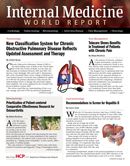Brief Report, Big Message: Profile of Pneumonia Pathogens Changed
A letter published online in the Journal of the American Medical Association presents the first microbiologic pathogens trend analysis in hospitalized patients in the United States.

A letter published online in the Journal of the American Medical Association presents the first microbiologic pathogens trend analysis in hospitalized patients in the United States. The research team used the Nationwide Inpatient Sample, which aggregated data from roughly 20% of US hospital admissions over almost 2 decades. Their report supplements—and confirms—previous findings that the introduction of the pneumococcal vaccine in 2000 lead to fewer Streptococcus pneumoniae pneumonia admissions.
In the study periods, pneumonia hospitalizations increased from 350.4 to 442.4 per 100,000. In actual numbers, hospitalizations increased from 910,676 to 1,378 551 annually. In 1993, 65.9% of admissions had no reported pathogen; by the end of the study, that number had increased to 83.9%. Clinicians were almost 30% more likely to have identified pathogens in patients admitted with non-pneumonia principal diagnoses than those admitted for pneumonia as a primary diagnosis.
In 1993, Streptococcus pneumoniae was identified most often. By 2011, Staphylococcus aureus (and mostly methicillin-resistant S aureus) was the most common pathogen, increasing from 3.6% to 3.9%. This low rate suggests that MRSA coverage is not routinely indicated for patients with community-acquired pneumonia.
There were 3 bacterial species that declined significantly:
· Streptococcal species declined from 7.1% to 2.3%
· Pseudomonas declined from 3.9% to 2.3% , and
· Haemophilus influenzae declined from 3.6% to 0.4%
The researchers note that better immunization uptake, more effective vaccines, and herd immunity from increased pediatric vaccination since 2000 may have caused the decline in adult S pneumoniae pneumonia. They also suggest that quality improvement interventions encouraging early antibiotic administration may affect the ability to read cultures, reducing positive results.
These findings are important because pneumonia remains the leading cause of infectious death in the United States.
